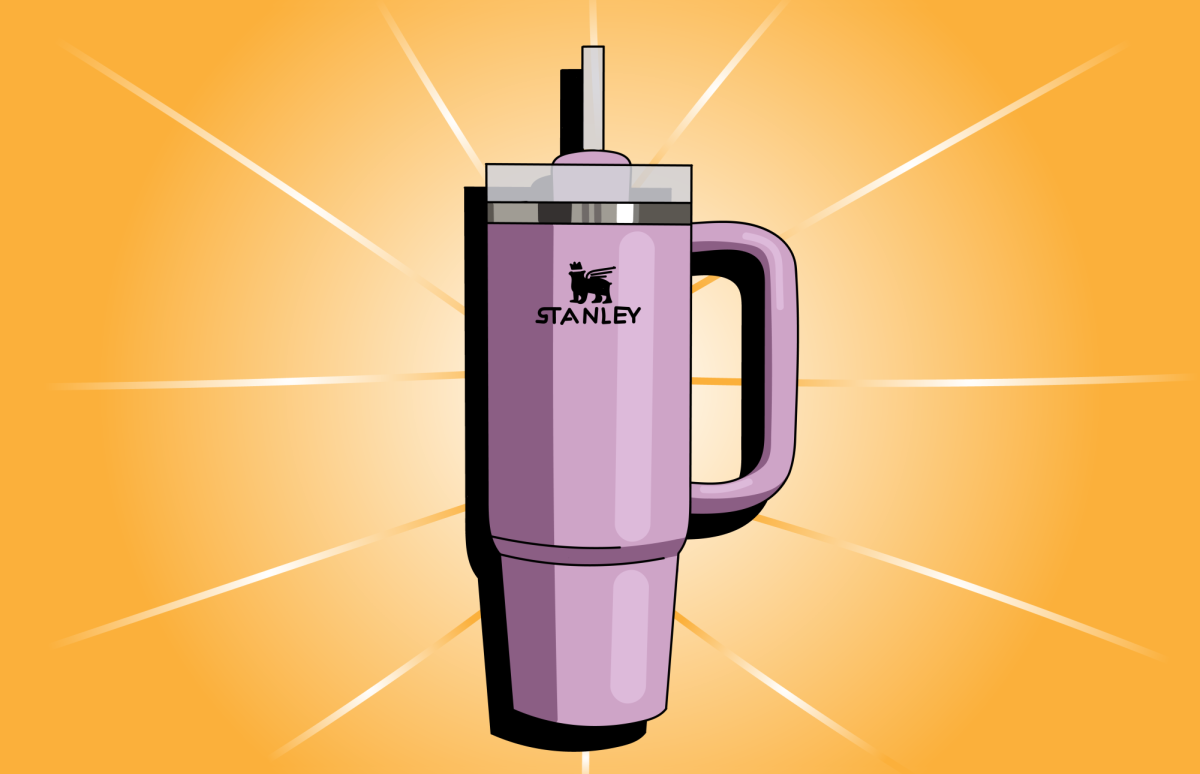A new wave is sweeping the country, bringing flocks of people to stores, creating division on social media and perpetuating mass consumerism: the popular Stanley cup.
The Stanley brand has existed since 1913, when the inventor William Stanley Jr. invented the all-steel vacuum bottle. Since its founding, the brand has been known for its durable water bottles and prioritization of functionality and practicality.
Today, the brand has garnered a new reputation. The brand sells a multitude of styles of bottles, but the one that has risen to popularity recently is the “Quencher,” coined by the public as the “Stanley cup.”
Bringing water bottles to school is not a new concept. Step into any classroom, and you are bound to see quite a few water bottles, but recently, the Stanley Quenchers have taken over.
With their rise in popularity, the cups have also become controversial. Some people love them, even collecting them and buying them in every color they can find. Other people have criticized them for their size, lack of functionality and promotion of consumerism.
Sophomore Paul Evans owns one Stanley Quencher and is an avid Stanley supporter. He bought his Stanley Quencher bottle in November 2023 and uses it every day.
“I think that it’s the best water bottle because, say, I put ice in it at like 6 p.m., the ice will be there at 6 p.m. the next day, unmelted,” said Evans. “Also, it can fit in my cup holder because it has a narrow bottom, and it’s still 40 oz because most 40 oz water bottles have fat bottoms.”
Evans says he chose to buy a Stanley because they are popular and he wanted a new water bottle to put stickers on.
While Evans finds the bottles super practical and functional for him, other students disagree.
Junior Lucas Greene uses a Klean Kanteen water bottle and finds the Stanley Quenchers impractical and dangerous.
“I don’t understand Stanley cups because it’s like a giant deadly piece of metal that we’re allowing people to carry around at school,” said Greene. “Also you can’t put it in a car holder, you can’t put it in a backpack, you have to carry it around, it’s like carrying a milk jug of water.”
The water bottles have blown up on social media platforms like TikTok and Instagram and, according to CNBC the brand’s revenues have more than doubled from $194 million in 2021 to $402 million in 2022 after releasing a redesigned model with a new array of colors.
These new colors have been a big component of the bottle’s success. The bright pastels made them popular, especially among young women. With the Quenchers coming in over 100 colors and designs, many people have begun collecting them, flaunting their array of bottles in different colors on social media.
“I think that collecting them is extra because you can only need one,” said Evans. “You can’t use multiple at the same time. I get you want to have different colors, but if it’s 45 dollars for a water bottle and you’re buying multiple. You must be rich.”
This Stanley collection has also raised concerns about overconsumption. While the Quenchers are reusable water bottles known for durability, many people have pointed out the irony of these symbols of sustainability becoming symbols of overconsumption.
“I don’t like that a lot of people collect them,” said Senior Maya Alvarez. “I don’t like the idea that something that is meant to be safe for the earth like a reusable water bottle is something that people want to buy more and more of. It eliminates the purpose of it.”
The incredible popularity of Stanleys has affected local businesses as well. According to Steve Frazzano, the assistant manager at Ace Hardware in Kalamazoo, after beginning to sell Stanley cups around 6 months ago, they have been flying off the shelves and have even been stolen.
“It’s kind of an unfortunate incident,” said Frazzano, describing an incident two weeks ago when the cups were stolen. “What happened was two people came in. One person kept our cashier busy, and the other person put 10 Stanley cups in a cart while the cashier was busy with the other person who was with them, took those right out the door, went right to the car, unloaded those cups into the car, and left.”
At Ace, this incident seems to be unique to the Stanley cups. Frazzano noted that while the store has all kinds of Yeti products on display, they’ve never had a major problem with them being stolen.
“That’s usually a good indication of a product that’s popular, is that people start stealing them,” said Frazzano. “We have actually had to take them off the shelves and put them behind the counter where the cashiers are. We have them on display with a sign that says that the Stanley bottles are available in various colors and so forth.”
Many people still enjoy using Stanley cups and want to continue using them. Is it possible for people to appreciate nice water bottles without these negative effects?
Alvarez says she has had the same water bottle for years, and there is no reason to buy a new one if the one she owns is perfectly good. She brings up an important way that reusable water bottles can remain sustainable, even Stanleys.
If you need a new water bottle, and you like the design and functionality of the Stanley Quenchers, there’s no reason not to buy one. However, if you already have a perfectly good water bottle, especially if you already own a Stanley Quencher, the more sustainable option would be to use it as it is intended: re-use it.










